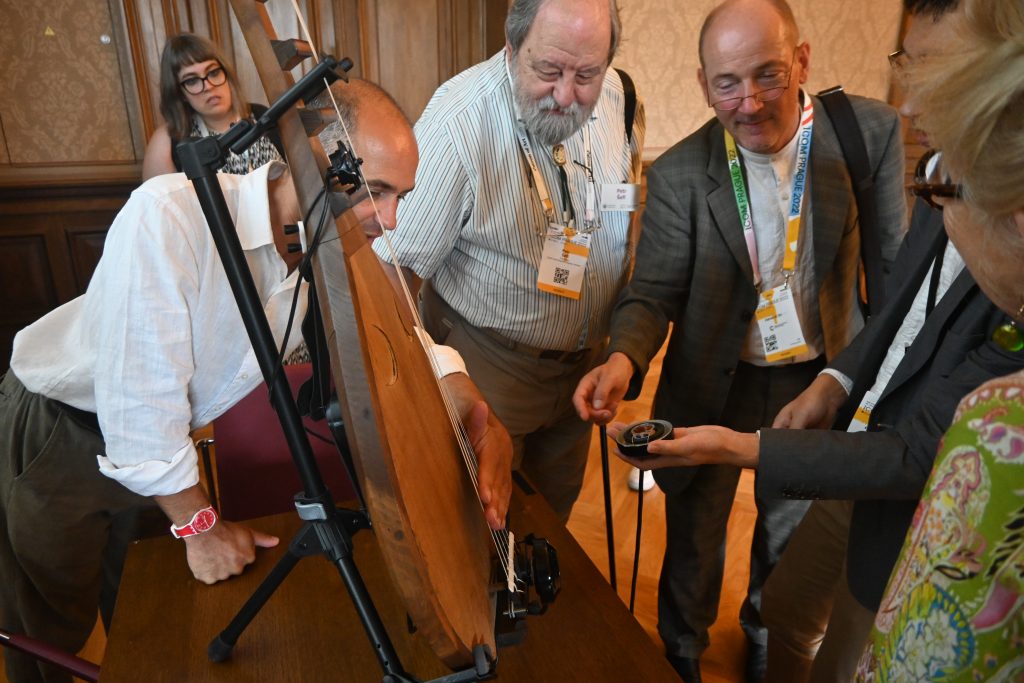
January 4, 2024
Exchanging Opinions and Networking Opportunities at CIMCIM
Sawako Ishii
Curator
Hamamatsu Museum of Musical Instruments
Hamamatsu Museum of Musical Instruments and CIMCIM
The Hamamatsu Museum of Musical Instruments (hereinafter referred to as “the Museum”) is a musical instrument museum that opened in 1995 as part of Hamamatsu City’s initiative, “Creation of a City of Music.” The Museum collects and preserves musical instruments with an equal and unbiased perspective from around the world and has been engaged in various activities, such as exhibitions and concerts, aiming to “introduce the cultures of people from various regions and times through musical instruments and music.” In 1995, the Museum joined ICOM, and since 2014, it has also participated in the annual meetings of CIMCIM (International Committee for Museums and Collections of Instruments and Music).
CIMCIM is one of the international committees affiliated with ICOM. Since its establishment in 1960, its primary activities have included utilizing and preserving musical instruments and music materials and establishing its standards for such activities. The committee holds an annual meeting with a program consisting of presentations, panel discussions, visits to related facilities, and lecture recitals over several days.
Until now, the Museum has made presentations at the annual meetings regarding special exhibitions, CD production using the collection of musical instruments, concerts, and workshops (Image 1). At the 2019 ICOM Kyoto General Conference, the Museum coordinated the CIMCIM meetings and planned and conducted excursions to related facilities, including the Museum (Images 2 and 3).
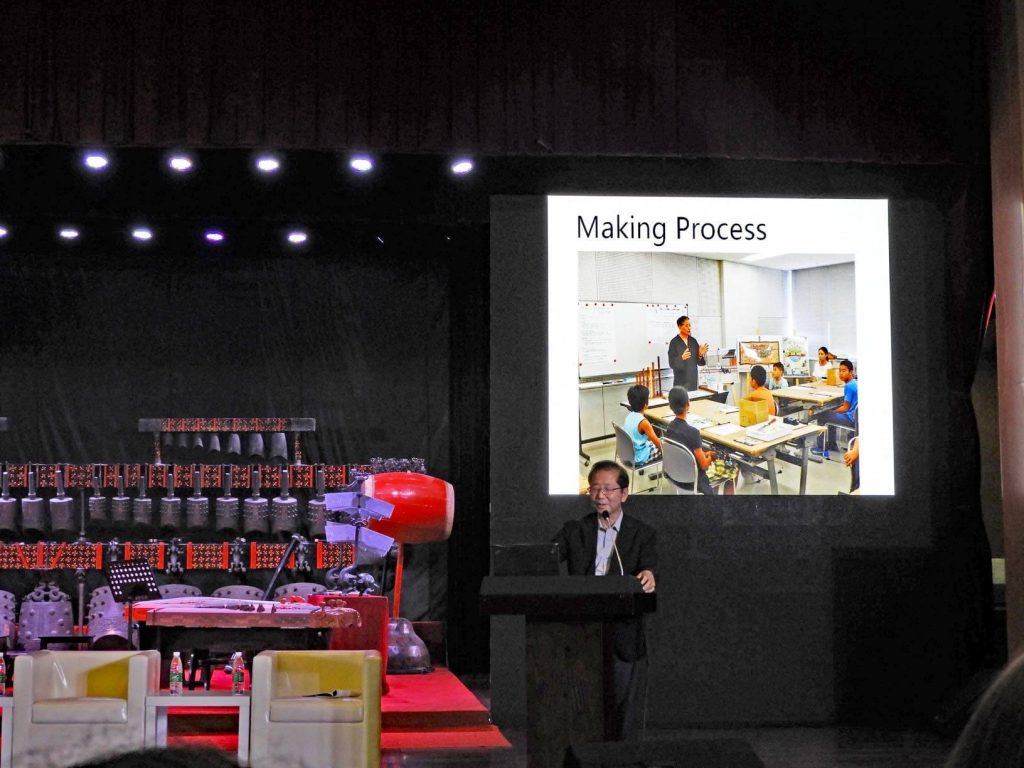
Presenting the trial workshop for the production and performing experience of Japanese instruments

Scene from a CIMCIM excursion at the Hamamatsu Museum of Musical Instruments
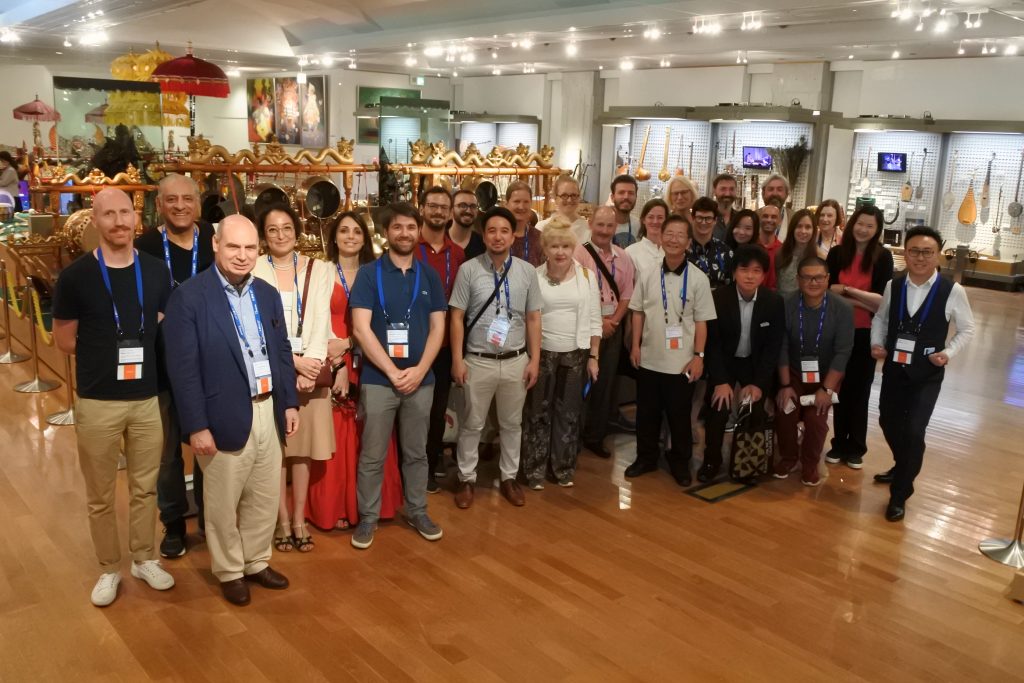
Group photo at the Hamamatsu Museum of Musical Instruments
In Japan, very few museums handle musical instruments from around the world, and examples of collection management and utilization are limited. Therefore, building relationships with musical instrument museums worldwide through activities in CIMCIM and learning from relevant cases abroad is essential. Additionally, serving as the only public musical instrument museum in Japan, we also play a significant role in promoting Japan’s musical culture.
I have been attending the annual meetings of CIMCIM since 2021. In this article, I will first touch upon the overview of my presentations at the meetings. Following that, I will report on the presentations and trends of the annual meeting held in the Netherlands from August 30 to September 1, 2023.
Initiatives Presented at Recent CIMCIM Annual Conferences
In 2021, the CIMCIM annual meeting took place for the first time since the 2019 ICOM Kyoto General Conference (the 2020 meeting was canceled due to the widespread impact of the COVID-19 pandemic.) The central theme was “Global Crises and Music Museums: Representing Music after the Pandemic.” The reports included discussions on organizing virtual exhibitions and building databases as digital platforms. The Museum also reported on its online initiatives undertaken in response to the closure during the pandemic, presenting it as a case study of “Online Museum Education in the COVID-19 Era” (Images 4 and 5). Although it was not possible to have face-to-face interactions with the participants due to the meeting being entirely online, it provided a valuable opportunity to share the activities and prospects of each institution, looking ahead to the post-pandemic era.
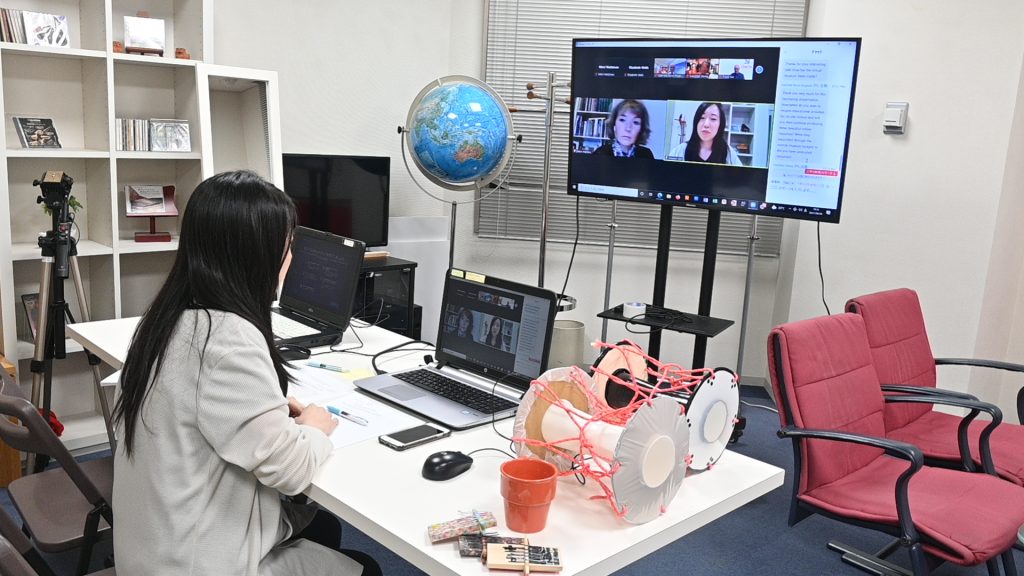
Introducing educational outreach activities such as video production and establishment of the virtual museum
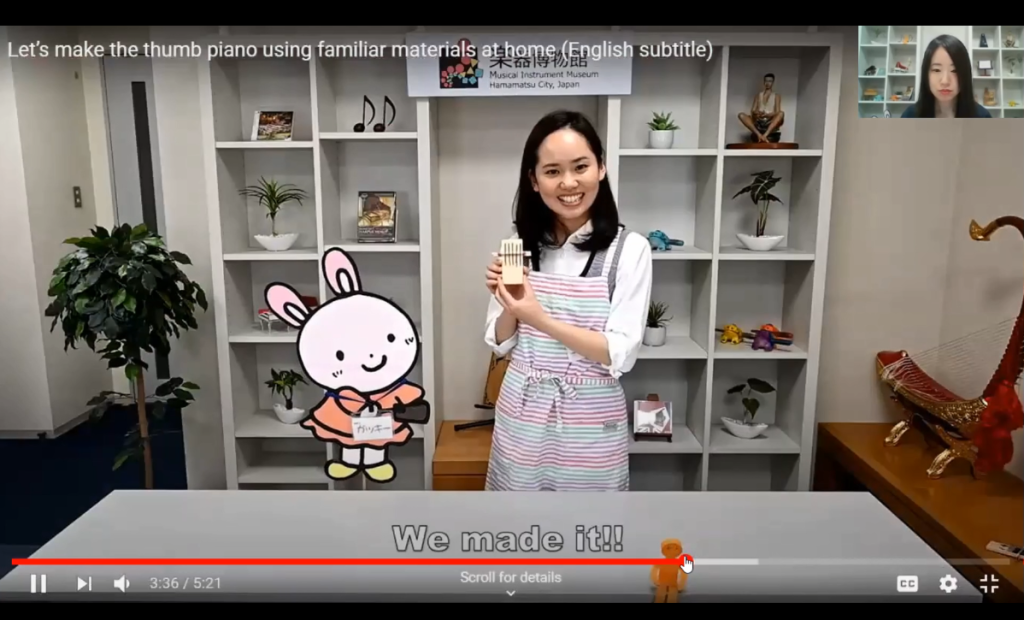
The 2022 annual meeting occurred during the ICOM Prague General Conference (adopting an on-site and online hybrid participation format). There were presentations on the “decolonization” of music museums and the preservation and succession of musical heritage, totaling around 20 presentations surrounding the central theme of “Music Museums: Social and Environmental Responsibilities and Identities in the 21st Century.” During this conference, we reported on an exhibition initiative focused on the preservation and succession of Japan’s culture and identity deeply intertwined with the Biwa that is at risk of being lost or forgotten (Images 6 and 7).
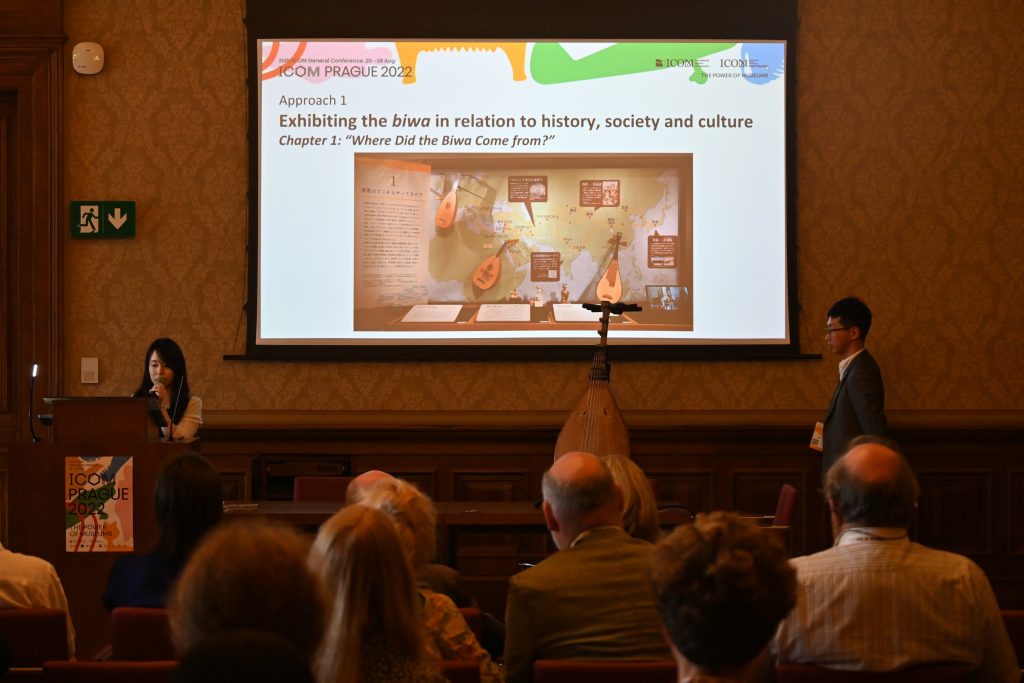
Presenting the innovative exhibition techniques used in “Biwa: Story of its Soul and Form” exhibition at the CIMCIM conference

CIMCIM Annual Meeting 2023: Presentations and Trends
This year’s annual meeting took place from August 30 to September 1 with the central theme, “Prospects and Challenges of Museum Accessibility, Diversity, and Equity.” The hybrid conference was held online and across various venues in the Netherlands, including Amsterdam, Utrecht, Amersfoort, and Heerde, attracting approximately 130 participants (96 attended on-site). There were 70 speakers from 20 countries, making it the largest gathering in the conference’s history. While each speaker’s presentation time was shorter than in previous years, it allowed more opportunities to explore more cases.
During a “Approaches to Inclusivity and Diversity” session, the Museum presented “Mobile Musical Instrument Museum,” an outreach program we have been undertaking since 2000. This program involves visiting local elementary schools and conducting classes on musical instruments from all over the world. This program has been implemented for over twenty years to include children as museum visitors. Compared with adults, children have a disadvantage in gathering information and visiting the Museum independently. Moreover, they feel hesitant about visiting museums due to their impression that exhibits are “hard to understand” or due to the numerous rules and expectations that must be followed.
The “Mobile Musical Instrument Museum” program aims to overcome these challenges children face. It serves as an “entrance to the musical instrument museum,” where they can experience the excitement and surprise of interacting with instruments. The program also aims to contribute to the education of international understanding by presenting instruments not only as “objects that produce sound” but as items that “provide insights into the culture, lifestyle, and natural environment of the country or region they originate from.” In our presentation, we highlighted three instruments featured in the “Mobile Musical Instrument Museum” and explained how we introduced them to the children. Also, we played a video of the children taking quizzes and interacting with the staff to show the creative ways we had piqued their interest (Image 8).
We reported some comments from the children’s feedback notebook, such as “I want to visit the museum next time” and “I wasn’t interested in musical instruments before, but after playing them myself, I want to hear the sounds of more instruments.” After the presentation, we had comments from the audience, “How wonderful it was to see the children’s excitement and the interactions with the staff.” However, we also received feedback that the materials of musical instruments may not necessarily “provide insights into the natural environment of the country or region they originate from” and that the museum experience through the “Mobile Musical Instrument Museum” differs from the experience in museums that exhibit historical instruments. The diverse perspectives we obtained here are precious for improving this program and other museum activities in the future.

Presenting the “Mobile Musical Instrument Museum” with a video
As part of the initiatives towards inclusivity and diversity, there were presentations on the development of appreciation tools for users with visual or auditory impairments, as well as research and exhibitions highlighting the diverse entities in the history of music and instrument-making. In another session, themes such as “Sound Accessibility” and “Digital Accessibility of Musical Instrument Collections” were explored, focusing on examples of utilizing digital technology. Additionally, in a session themed “Transfer of Collections from Private to Public Spaces,” there were presentations introducing cases of private collections donated to universities and museums in recent years, along with reports on the research and exhibition of such collections.
I would also like to touch upon the interest in “Provenance,” which has become a global trend within musical instrument museums and was a theme discussed at the annual meeting. Borrowing the words from the keynote lecture, the provenance of the items in a collection (the transitions of ownership leading to the museum’s acquisition) is valuable information that proves the legitimate ownership of the items and serves as practical information to navigate complex situations related to law, customs, and crime. As museums are being questioned about their “ethics,” there is a growing movement, especially in the United States and Europe, to reveal objects that have been looted, stolen, or otherwise accessioned through unauthorized channels and return them to their proper owners. The term “Provenance” has been incorporated into CIMCIM’s strategic plan through 2025, and there are ongoing discussions on addressing this issue, with particular emphasis placed on working groups’ efforts.
In the session on “Provenance” during the annual meeting, ten presenters reported on the status of provenance research in their respective institutions and countries.1 The content included:
1) Requirements and practices related to provenance
2) Pre-acquisition procedures
3) Availability of guidelines provided by ICOM national committees or other professional associations
4) Availability of national guidelines, tools or resources on provenance
I also participated in this session as a presenter representing Japan (Image 9). According to the Japan Association of Museums, which I contacted before the annual meeting, suitable guidelines or tools for provenance research were not made public at the ICOM Japan Committee or the national level. During the presentation, I conveyed the current situation and procedures at the Hamamatsu Museum of Musical Instruments and emphasized that museum collections in Japan adhere to ICOM Code of Ethics, which mentioned the ethical considerations for collection in the “General Rule of Museums and Code of Conduct for Museum Professionals” proposed by the Japan Association of Museums. I also reported on the increasing interest in provenance research in government projects related to the expanding art market.
Some presenters at this annual meeting (including myself) had initially declined to present; still, the host acknowledged that the absence of information on provenance research was valuable and ended the session on that note. There were presentations on the practices of provenance research and information management in a subsequent session, and there was even an online report from a musical instrument museum in Ukraine on the current situation where they are facing the crisis of looting and destruction of their collection.
It would not be truthful to say there is a lively debate on the importance of “provenance” in Japan. However, according to a presenter who is the curator of the National Museum of Indonesia, documents detailing the provenance of music-related materials in their possession were likely lost during Japan’s colonial rule. This perspective highlights the need for Japan to consciously acknowledge and address its occupation’s impact on other nations’ cultural heritage and collections.
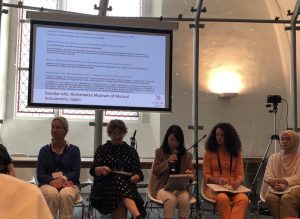
Reporting on the Current Situation in Japan during the “Provenance” Session
During the annual meeting, there was an opportunity to visit the exhibitions and conservation and restoration facilities of each museum that served as the venue. On the final day, we visited the CollectieCentrum Nederland (CCNL), a large-scale storage facility established through the collaboration of four institutions2 responsible for the country’s collection management, which houses a diverse range of materials, not limited to musical instruments but also including paintings and crafts, large carriages, and thrones for the royal family. We also had an opportunity to converse with the specialists and learn about effective methods of displaying and preserving musical instruments.
Reflecting on Participation in CIMCIM: The Significance of International Engagement
Participation in international forums provides valuable opportunities for the exchange of ideas and serves as a helping hand for museum operations. This year’s annual meeting provided immense and invaluable practical examples from presentations and museum visits. I was able to deepen my relationship with other professionals from other institutions, gather firsthand information about items in our collection, and receive strong encouragement regarding the exhibition we are planning for next year. Also, through the connections made at the annual meeting, I was introduced to a colleague who is a curator in charge of the Asian region and coincidently preparing for an exhibition on Japanese musical instruments in 2025. He is planning to visit our museum next year. How wonderful it is to have made a connection where we will not only enhance each other’s exhibitions but also contribute to the international understanding of Japan’s musical culture.
Sharing our initiatives through presentations is crucial for advancing and improving museum activities. The professional opinions and advice received from participants serve as important hints when evaluating current efforts or planning improvements in the future. Some participants even remembered past presentations that led to further conversations during the annual meeting. Continuing to participate in and contribute presentations to these conferences will lead to our museum’s visibility. Through this network of domestic and international understanding and support, we can fulfill our mission as a museum dedicated to showcasing the world’s musical instruments.
Participation in international committees is essential for staying informed about global museum trends. As mentioned earlier, the themes and topics addressed by CIMCIM go beyond issues specific to musical instrument collections. They confront challenges common to museums and society, such as being inclusive and operating and communicating ethically as emphasized in the new museum definition. I hope there will be opportunities within Japan to introduce the practical activities of CIMCIM to address these challenges in the future.
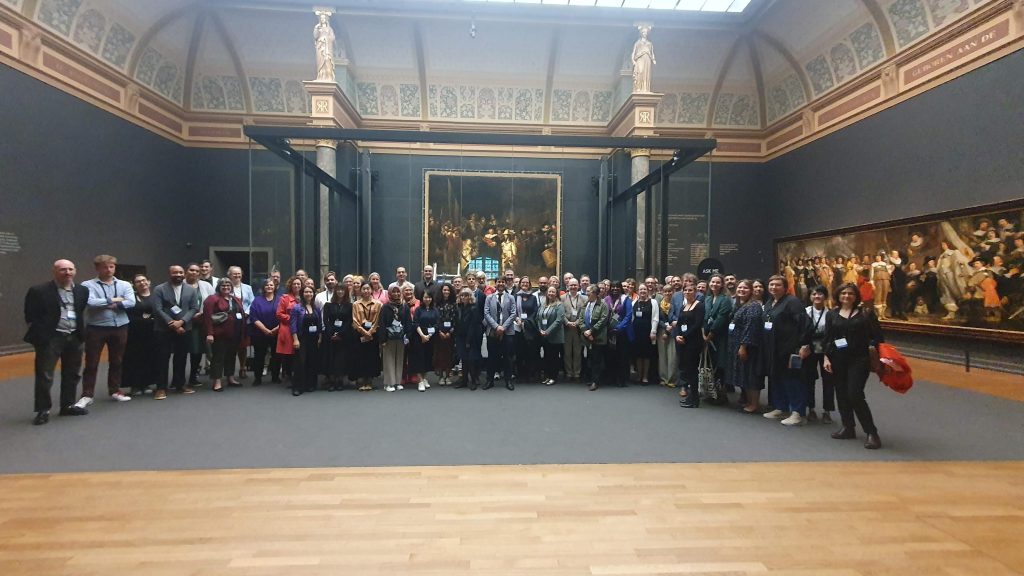
Group Photo at the Rijks Museum
(Sawako Ishii)
Hamamatsu Museum of Musical Instruments